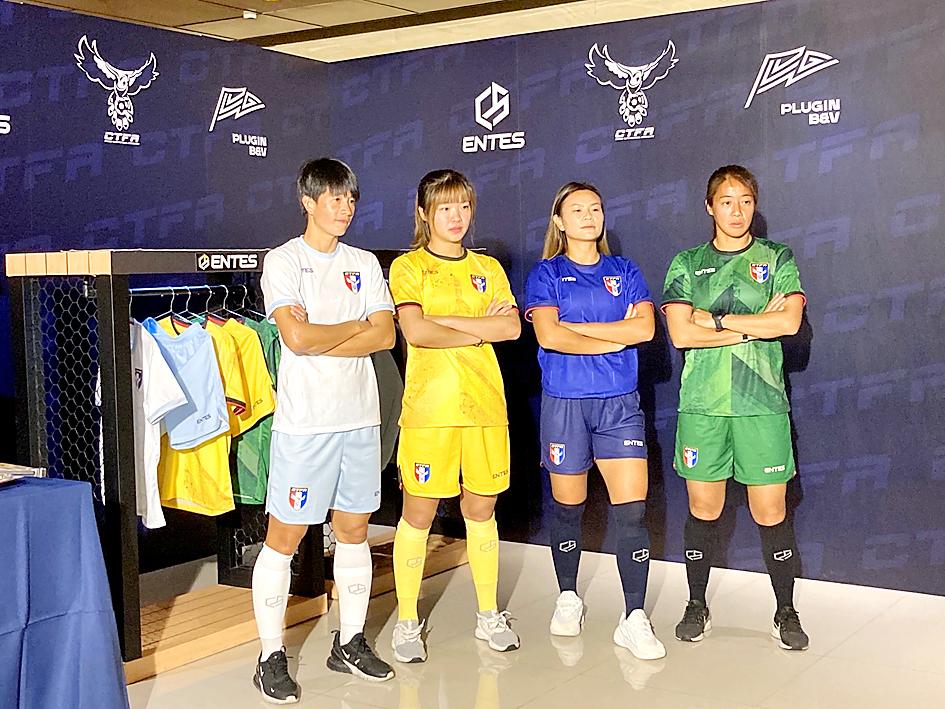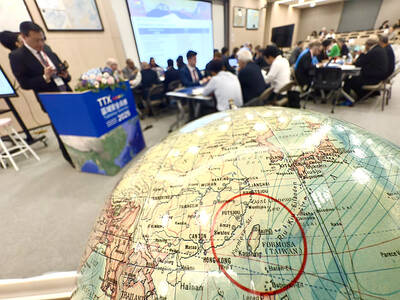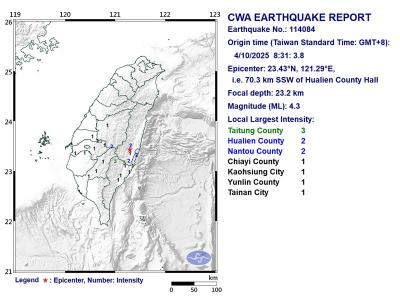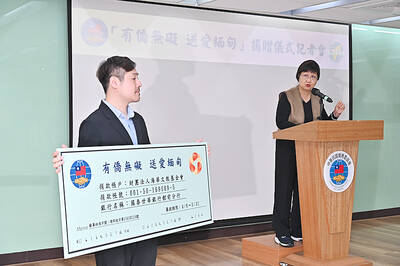The women’s national soccer team made its mark on the soccer world stage with a stellar performance at the Asian Football Confederation (AFC) Women’s Asian Cup in India last month and early this month, with fans at home and abroad increasingly adopting the nickname “Blue Magpies.”
Surviving the group stage with a 5-0 win over Iran, the team qualified for a 10-team inter-confederation play-off tournament in February next year, where the Blue Magpies are to try to qualify for the FIFA Women’s World Cup in Australia and New Zealand later that year.
A draw in the playoffs against Vietnam at the Asian Cup, which would have sent them directly to women’s soccer’s biggest stage, was narrowly denied, after the Blue Magpies put up a good fight, but lost 2-1 in Navi Mumbai on Sunday last week.

Photo: Wu Meng-ju, Taipei Times
After the narrow defeat, sports journalist Elton Chen (陳志祥) lauded the team and commented on their emblem, implying that it is outdated.
“It is time that the Chinese Taipei Football Association’s [CTFA] new logo represents Taiwan’s national squads,” he said, adding that it should become “a symbol for Taiwanese to rally around at international competitions.”
Chen said that the team’s old nickname, “Mulan,” should not be used any longer and suggested calling them Blue Magpies, as a flying magpie carrying a soccer ball is depicted in the team’s logo.
“Taiwan soccer must catch up with the times. New technology, along with democracy and free elections, have taken hold in Taiwan after the Martial Law era ended in the late 1980s,” he said. “Mulan belongs to the old regime, when Taiwan was a one-party state and the military was in charge of soccer.”
When unveiling the magpie logo eight years ago, the CTFA said: “It is appropriate for the Formosan blue magpie to represent the nation, as it has a highly distinctive and colorful plumage. It is a native species of Taiwan. With its beautiful feathers and attractive appearance, it is beloved by the public and has been voted to become Taiwan’s national bird.”
The blue magpie is a social bird, but when attacked, it defends its nest assertively, the association said, calling it representative of the teamwork and passion needed in a soccer match.
In the 1960s, Taiwan were regarded as the powerhouse of women’s soccer in Asia, winning several regional titles.
However, when Beijing a decade later started pressuring Taiwan and narrowing its space on the international stage, the nation was in 1974 expelled from the AFC and its competitions, in which it until then participated under its formal name, the Republic of China.
Taiwan rejoined the regional soccer governing body in 1989 — as “Chinese Taipei.” Despite these limitations, the women’s team continued to be competitive, first playing under the Mulan nickname in 1975 at home and two years later playing under that name in Thailand, Singapore and Indonesia.
The idea to use that name came from then-CTFA chairman General Cheng Wei-yuan (鄭為元), who said he wanted to honor Hua Mulan (花木蘭), a legendary Chinese folk heroine from the Northern and Southern dynasties period who later inspired two Disney movies.
In those times, the then-Chinese Nationalist Party's (KMT) authoritarian rule had most sports governing bodies placed under subordination of military commanders, and that the KMT regime's Sinicization policies were quite effective.
Told in folk song known as "The Ballad of Mulan" from the fifth century during China's North Wei Dynasty (北魏), Hua Mulan disguised herself as a man to save her ill father from emperor's army conscription order, and she fought with distinction as a brave warrior in fighting wars against nomadic tribes.
Most renderings had Mulan as a Chinese woman who had to hide her gender to serve in the army as a horse-riding warrior.
The story became popularized for Western audience through Disney's animation cartoon in 1998, and then "Mulan" the live-action movie in 2020, which led to numerous controversies, including critics who said it had distorted Chinese history and catered to Han Chinese ethno-nationalism.
In recent years, academics and historians have presented evidence that Hua Mulan was not ethnic Han Chinese, and instead belonged to a tribe that is considered a predecessor of modern Mongolians.
Critics added that the Mulan story, instead of empowering women, re-enforced Chinese patriarchy, Confucian filial piety values and traditional gender stereotypes as she had to go home in the end, returning to her role as a serving daughter and a housekeeper.
Chen, too, said that the name is too closely identified with China.
Taiwanese soccer needs to move forward, and should not use the Mulan nickname for its women’s national team, Chen said.
“The Hua Mulan story is about military campaigns in what are now northern China and Mongolia; it is about conquering and subjugating nomadic tribes,” Chen said. “It has nothing to do with Taiwan.”
British soccer fan and Taipei resident Nick Wheeler said he supports using Blue Magpies instead of Mulan, adding that the bird, “with its beauty and uniqueness, it is a fitting symbol for Taiwan.”
"It seems inappropriate for the female team to be nicknamed as Mulan, a historic character who disguises her gender," he added. "Taiwan national team is full of proud women who are honored to represent their country."
British Taiwan resident Mark Buckton echoed Wheeler and added: “Given all the historical baggage that comes with the [Mulan] name, and factual inaccuracies surrounding the origins of the real Mulan, it is high time the CTFA, and Taiwanese sports in general, start to change this outdated moniker.”
“Taiwan women’s national team, as well as the women’s soccer league [Taiwan Mulan Football League], both deserve an original, Taiwan-based nickname that will help instill pride, instead of having to drag around the now-widely ridiculed ball-and-chain that is all things Mulan,” Buckton said. “The Formosan Blue Magpie, as on the CTFA emblem, is a natural choice as a rallying symbol for national soccer.”
Cheng Shien-meng (鄭先萌), soccer broadcaster for Taiwan’s Sportcast TV and Fox Sports, said that successful national teams all have nicknames, often based on their logos or colors.
England’s team are known as the “Three Lions,” Italy’s as the “Azzurri” and Argentina’s as “La Albiceleste,” Cheng said.
Other team nicknames predominantly used in Taiwan — the “Spanish Armada” or the “German Tank” — refer to the respective nation’s own history, instead of that of other nations, he said.
Blue Magpies is a fitting name for Taiwan’s women’s national soccer team, Cheng said, adding that nicknames usually emerge from among fans of the respective team, not by decree from the nation’s soccer governing body.
This story has been amended since it was first published.

Taiwan is stepping up plans to create self-sufficient supply chains for combat drones and increase foreign orders from the US to counter China’s numerical superiority, a defense official said on Saturday. Commenting on condition of anonymity, the official said the nation’s armed forces are in agreement with US Admiral Samuel Paparo’s assessment that Taiwan’s military must be prepared to turn the nation’s waters into a “hellscape” for the Chinese People’s Liberation Army (PLA). Paparo, the commander of the US Indo-Pacific Command, reiterated the concept during a Congressional hearing in Washington on Wednesday. He first coined the term in a security conference last

DEFENSE: The National Security Bureau promised to expand communication and intelligence cooperation with global partners and enhance its strategic analytical skills China has not only increased military exercises and “gray zone” tactics against Taiwan this year, but also continues to recruit military personnel for espionage, the National Security Bureau (NSB) said yesterday in a report to the Legislative Yuan. The bureau submitted the report ahead of NSB Director-General Tsai Ming-yen’s (蔡明彥) appearance before the Foreign and National Defense Committee today. Last year, the Chinese People’s Liberation Army (PLA) conducted “Joint Sword-2024A and B” military exercises targeting Taiwan and carried out 40 combat readiness patrols, the bureau said. In addition, Chinese military aircraft entered Taiwan’s airspace 3,070 times last year, up about

A magnitude 4.3 earthquake struck eastern Taiwan's Hualien County at 8:31am today, according to the Central Weather Administration (CWA). The epicenter of the temblor was located in Hualien County, about 70.3 kilometers south southwest of Hualien County Hall, at a depth of 23.2km, according to the administration. There were no immediate reports of damage resulting from the quake. The earthquake's intensity, which gauges the actual effect of a temblor, was highest in Taitung County, where it measured 3 on Taiwan's 7-tier intensity scale. The quake also measured an intensity of 2 in Hualien and Nantou counties, the CWA said.

The Overseas Community Affairs Council (OCAC) yesterday announced a fundraising campaign to support survivors of the magnitude 7.7 earthquake that struck Myanmar on March 28, with two prayer events scheduled in Taipei and Taichung later this week. “While initial rescue operations have concluded [in Myanmar], many survivors are now facing increasingly difficult living conditions,” OCAC Minister Hsu Chia-ching (徐佳青) told a news conference in Taipei. The fundraising campaign, which runs through May 31, is focused on supporting the reconstruction of damaged overseas compatriot schools, assisting students from Myanmar in Taiwan, and providing essential items, such as drinking water, food and medical supplies,